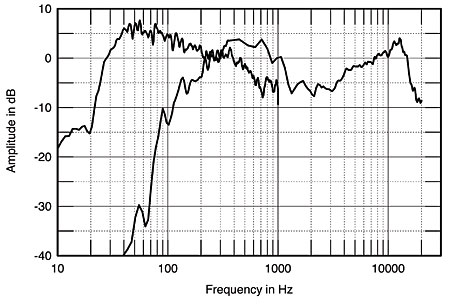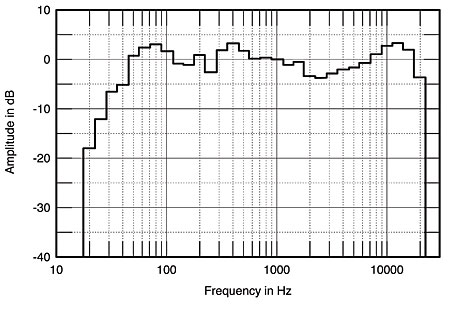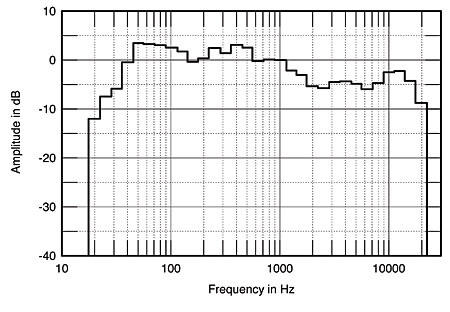| Columns Retired Columns & Blogs |
Legacy Audio Whisper loudspeaker Measurements
Sidebar 3: Measurements
Because of the Legacy Whisper's bulk and mass, I decided to measure the speakers in situ in Paul Bolin's Minnesota listening room rather than have them shipped to my Brooklyn home. It wasn't possible, therefore, to do as complete a set of measurements as I usually perform.
The Whisper is specified as having a very high voltage sensitivity of 95dB/2.83V/m. It appeared to be just over 2dB more sensitive than the 90dB-sensitive Wilson MAXX 2, which PB was also auditioning during my visit (both figures B-weighted). However, the Legacy's impedance plot (fig.1) indicates that the speaker is quite a demanding load, at least at high frequencies. While the woofer section (shown to the left of this graph) drops below 4 ohms only between 24Hz and 29Hz, the midrange-tweeter section drops to 4 ohms at 3kHz and reaches a minimum value of 2.75 ohms at 9kHz. In addition, the electrical phase angle is also quite large in the low treble, which will magnify the demands for current made by the speaker on the partnering amplifier. A hefty, 4 ohm–rated amplifier would seem mandatory for use with this speaker.

Fig.1 Legacy Audio Whisper, electrical impedance (solid) and phase (dashed). (2 ohms/vertical div.)
The impedance traces are free from the wrinkles and small discontinuities that would indicate the presence of cabinet resonances. The four 15" woofers, of course, are not mounted in a sealed enclosure, but listening to the midrange enclosure panels with a stethoscope while I played the stepped toneburst track from Editor's Choice (CD, Stereophile STPH016-2), I heard nothing untoward.
It didn't prove possible to take my DRA Labs MLSSA measuring system with me to Minnesota, so I was limited to measuring the Whisper's behavior in the frequency domain using the pink-noise signal on Editor's Choice as a source. I recorded the speaker's output at 1m on its ribbon-tweeter axis, using the Joe D'Appolito–designed Mitey Mike II (the flattest of my measuring microphones), as well as at 5°, 10°, and 15° to the sides of this axis, which is 41" above the floor. (At this microphone distance, the effect of the room acoustic will be small, though the use of a noise signal results in jagged-looking traces, despite the 1/10-octave smoothing I used.) I recorded the nearfield outputs of the woofers, the midrange units, and the rear-panel passive radiator using the same noise signal.
The results, analyzed once I was back in Brooklyn, are shown in fig.2. The trace above 300Hz shows the Whisper's output at 1m averaged across the 30° horizontal window centered on the tweeter axis. With this large a speaker at this microphone distance, there will undoubtedly be some proximity effect, which will tilt up the measured lower-frequency response. However, the step-down above 1kHz and the rise in on-axis output in the top two octaves do appear to be real.

Fig.2 Legacy Audio Whisper, 1/10 octave-smoothed spectral response on ribbon axis at 1m, averaged across 30° horizontal window and corrected for microphone response, with the nearfield responses of the midrange units and woofers plotted below 300Hz and 1kHz, respectively.
At low frequencies, the midrange array crosses over to the woofers at around 300Hz as specified, with initially quite a shallow slope. The woofers, too, feature a relatively slow rollout above the crossover frequency, meaning that they are still giving out significant energy in the midrange. The active LF processor was in circuit for this measurement, set to the control positions that Paul had been using for his auditioning. As well as equalizing the woofers' output to be flat below the frequency where the usual dipole cancellation occurs, it protects them from severe excursion demands by rolling them off below 40Hz or so with quite a steep (sixth-order) slope.
In the room, the Whisper's woofers will benefit from some boundary reinforcement to give extended lows. PB had the speakers relatively close to the corners of his room, but even then, the Whisper's spatially averaged response, taken in a vertical rectangular window centered on the position of his ears in his listening chair (fig.3), gently rolls off below the 50Hz band (footnote 1). Paul writes that, "When dialed in correctly...the Whisper produced bass that had the sheer speed and taut definition that characterize the best panel speakers." This is pretty much what I would expect from this measured response.

Fig.3 Legacy Audio Whisper, spatially averaged, 1/3-octave response in PB's listening room.
Higher in frequency, there is still evident a trace of the stepped-down low treble—PB did comment that the Legacy has "a slightly laid-back presentation"—with the top two octaves boosted in level. The speakers were toed-in to the listening position for this measurement, which puts the listener's ears on axis with the ribbons. However, the fact that this tweeter is mounted with its long axis horizontal rather than vertical means that its output falls off rapidly to the sides. Even so, Paul did write that the Whisper's top octave is slightly more forward than its mids and lower treble.
As this review was being prepared for publication, I visited Stereophile reader Carl Engebretsen, a passionate advocate for the Whispers. I performed an identical spatially averaged response of the Legacy speakers in Carl's room, again centered on the position of Carl's ears in his listening seat, but this time using an Earthworks QTC-40 microphone rather than the MM2. The result is shown in fig.4. Other than a difference in the 250Hz band, which will be due to room effects, the trace in this graph is very similar below 1kHz to that in fig.3. However, with the slightly-closer-to-the-corner speaker placement in Carl's room, the low frequencies extend a third of an octave lower than in Paul's room, which is larger.

Fig.4 Legacy Audio Whisper, spatially averaged, 1/3-octave response in Carl Engebretsen's listening room.
Listening to a selection of music in Carl's room, I was struck by how his system, based on the Whispers being biamped by 4.2kW of solid-state amplification, was optimized to do one thing better than almost any other system I have heard: capture the dynamic range and impact of live rock, particularly at low frequencies. His system's bass was superbly defined and extended and went extraordinarily loud without getting muddy, boomy, or distorted. The kick drum and bass guitar on an SACD of Jimmie D. Lane and Double Trouble (It's Time, APO CAPO 2020SA) were visceral as reproduced by the Whispers' eight 15" woofers. When I got home, a similar Stevie Ray Vaughan track played through the Snell LCR 7 XL speakers, which I reviewed in the June issue, sounded Lilliputian: rock music performed by midgets with toy instruments (though the Snells did space, midrange, and treble to a level of sophistication that Carl's Whispers couldn't match).
What puzzles me about figs.3 and 4, however, is the difference between the traces above 1kHz. The low-treble step-down is still apparent, but if the two traces are overlaid, the in-room response in Paul Bolin's room is tilted up by up to 5dB in the 12.5kHz band compared to the response in Carl's room. I could hear this relative lack of treble energy as a closed-in character on one of my own recordings: Hyperion Knight performing Gershwin's Rhapsody in Blue (CD, Rhapsody, Stereophile STPH010-2). I suspect that it comes, in part, from the fact that Carl has his Whispers so arranged that the ribbon-tweeter axes cross in front of his listening seat rather than being aimed at the listener's ears, as they had been arranged when I measured the speakers in PB's room. (I note that Paul had done the bulk of his auditioning using a more extreme toe-in than when I performed my measurements.) I also wondered if the difference was partly due to the relatively long run of 12-gauge speaker cable Carl was using with his Hafler DH-500 amps (bridged for mono, which doubles their output impedances) interacting with the low impedance of the Whispers in the mid- and upper treble.
It is important to note that a flat response is not the goal in in-room responses such as these. The spectral analysis is not only affected by the loudspeaker's on-axis frequency response, but also by its power response and how that interacts with the room's reverberant field. With a speaker such as the Legacy Whisper, which has a relatively narrow radiation pattern, the power response will not be flat but will slope down with increasing frequency. The exact degree of this slope will depend on the room, its furnishings, and how far the listener sits from the speaker.
I'm afraid that, without my being able to perform any quasi-anechoic measurements, the Legacy Audio Whisper's measured performance raises more questions than answers. However, I am confident that the speaker's balance will depend critically on the angle of toe-in.—John Atkinson
Footnote 1: For my in-room spectral analyses, I average six measurements at each of 10 separate microphone positions for the left and right speakers individually, using an Audio Control Industrial SA-3050A spectrum analyzer.—John Atkinson
- Log in or register to post comments




































